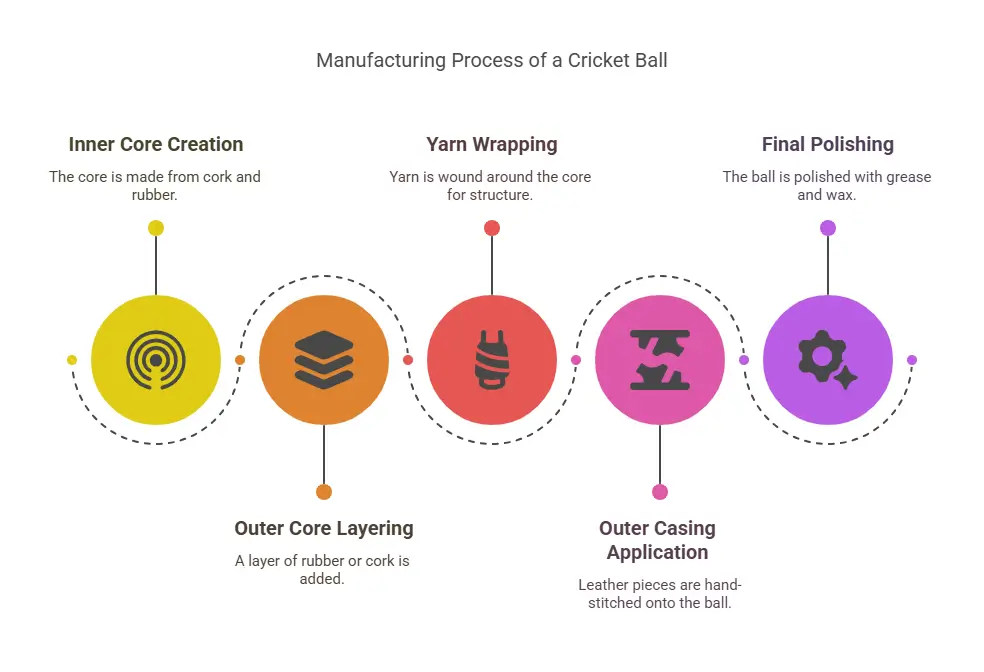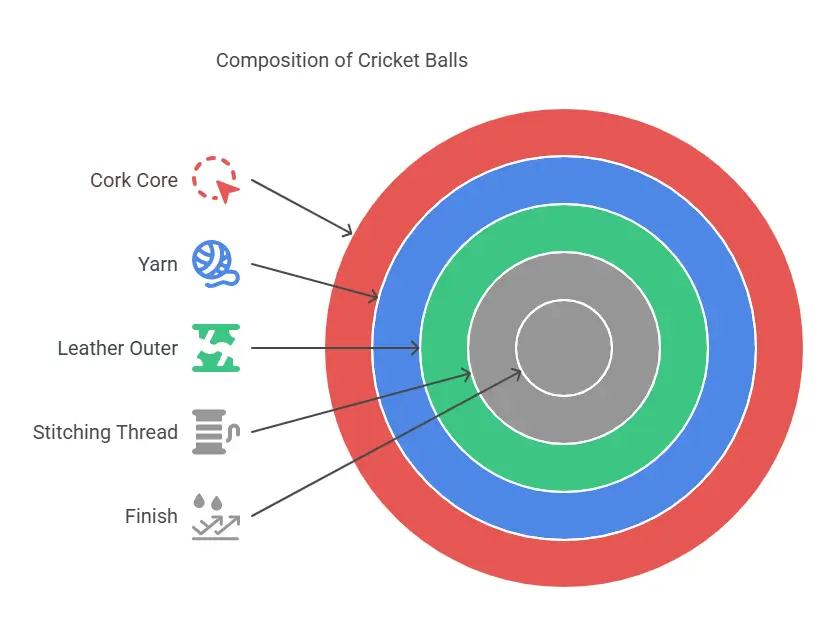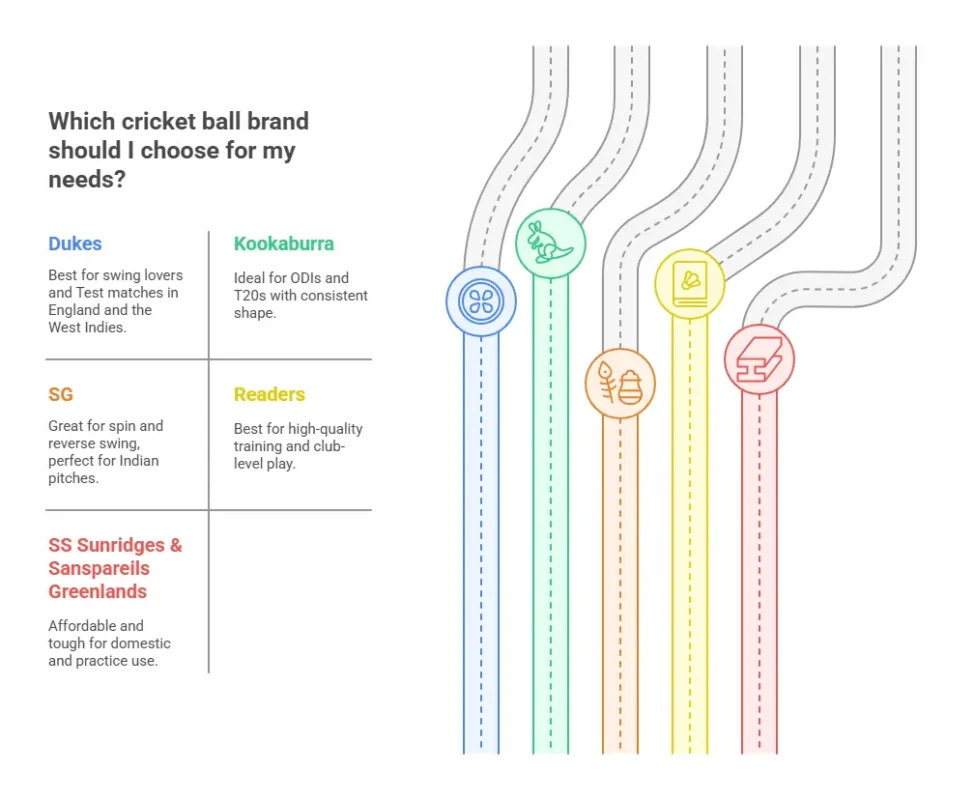What Is a Cricket Ball Made Of? Shocking Secrets

Okay, cricket lovers, let’s start the gossip, ever stopped mid-match and also thought, what is a cricket ball made of? No? Isn’t it just a leather or what? Let’s discuss about the cores, what’s the material on white, pink or red balls or even the steps of making all those.
What Is A Cricket Ball Made Of?
Okay, let’s break it down. It starts with a cork core wrapped tightly with layers of string plus a shiny leather cover stitched together. That’s it, ready to play on the pitch. So, at a glance here’s the list of the materials that made a cricket ball,
- A cork core,
- Tightly wound string,
- A leather cover,
- Sewn seam.
Who invented the Cricket Balls?
Ooh, now we’re getting into some serious discussion. Cricket balls were first made way back in the 18th century in England. The credit goes to the Duke family, as in Dukes cricket balls. They started making them in 1760, and they’ve been the OG ballsmiths ever since.
How Is A Cricket Ball Made?/ The Manufacturing Of Cricket Balls
Now it’s time to share the manufacturing secrets of the cricket ball to the stadium? Let’s break it down.

Stage 1 – The Inner Core
First things first, the inner core is the heart of the ball. It all begins with a small cork core, sometimes mixed with rubber. This is strong, solid and also ready to play all day long.
Stage 2 – The Outer Core
Next, the cork gets a layer of tightly compressed material ( rubber or cork again) to toughen it up. This layer adds weight and keeps the bounce.
Stage 3 – The Yarn
Now it’s time to wrap things up. Layers of fine woolen or polyester yarn are wound around the core by machine. This gives the ball shape & structure.
Stage 4 – The Outer Casing
Now let’s work for glow. Premium leather pieces (dyed red or white) are stitched around the core. But not just any stitching, we’re talking hand-stitched with thick linen thread. It’s the ball’s signature look.
Stage 5 – The Finish
Last but not least, the polish and shine part. The leather gets a coat of grease, polish and also sometimes a little wax to protect it and boost performance. Now the cricket ball is ready to play.
What Materials Are Used to Make Cricket Balls?
Alright, cricket lovers, a standard cricket ball isn’t just a chunk of leather, it’s a combo of a core, yarn & thread.

Cork Core: At the center compressed cork, mixed with rubber. This helps to bounce, provide durability and also maintain weight.
Wool or Polyester Yarn: This is tightly wound around the core in several layers. It gives the ball shape and helps it stay round (even after all those sixes).
Leather Outer: The outer shell is made of high-quality, dyed leather (usually red, pink or white).
Stitching Thread: Linen or polyester thread is used to hand-stitch the leather casing, six rows of stitches keep it tight and also pretty.
Finish: Grease, polish and also sometimes wax are used to waterproof the ball and glossy.
Rules of Using Cricket Balls in Matches
Oh yes, there are rules and also plenty of them. The Laws of Cricket are very clear about how balls must be used in matches:
Standard Weight & Size: A men’s cricket ball must weigh between 155.9 – 163 g and have a circumference of 22.4 – 22.9 cm.
Ball Changes: In Test matches, balls are typically changed after 80 overs. In ODIs, a new ball is used at each end (two total).
No Ball Tampering: Players are strictly prohibited from altering the ball using fingernails, teeth and also foreign substances. You can shine it with sweat or saliva.
Condition Matters: If the ball gets damaged, out of shape or lost, the umpires decide whether to replace it or not.
The Best Cricket Ball Manufacturing Brands
Here are the heavy hitters:

Dukes (UK): The best British brand. Hand-stitched, durable and used in Test matches in England and also the West Indies. Swing lovers are fond of this ball.
Kookaburra (Australia): The Aussie favorite and also a global go-to ODIs and T20s ball. Machine-stitched and famous for its consistent shape, though it can lose swing quicker than Dukes.
SG (India): The pride of Indian pitches. SG balls are hand-stitched, durable and also slightly softer than Dukes. Great for spin and reverse swing. Used in Indian Test matches.
Readers (UK): Best for high-quality training and also club-level balls.
SS Sunridges & Sanspareils Greenlands (India): Popular in domestic and also practice purpose. Affordable, tough and reliable to use.
Cricket Ball Official Dimensions and Why They Matter
Okay, size does matter, especially in cricket.
Officially, a men’s cricket ball must weigh between 155.9g to 163g and also have a circumference of 22.4cm to 22.9cm. That’s not just for looks. It’s all about balance, bounce and grip.
How Long Does It Take To Make A Cricket Ball?
You’d think it’s a quick job, but nope. Making a top-notch cricket ball takes around 3 to 5 days. From crafting that solid cork core to hand-stitching the leather and also polish settle. It’s slow but must be made carefully. Quality takes time.
White Cricket Ball, Red Cricket Ball and Pink Cricket Ball, What’s The Difference?
Time for some color discussion,
Red Cricket Ball: The OG of Test cricket. Used for day matches, red balls hold their shine and also shape longer in natural daylight. Plus, they just look classic.
White Cricket Ball: The limited-overs games like ODIs and T20s. White balls are used under lights and with colored kits, but they lose color and shine faster.
Pink Cricket Ball: Used in day-night Test matches, pink balls are easier to see under lights and also have a special coating to stay bright. It’s basically red ball’s cousin who went to art school.
Pros and Cons Between White Cricket Ball, Red Cricket Ball and Pink Cricket Ball
Let’s break it down like a cricket group chat:
| Ball Type | Pros | Cons |
| Red | Durable, great for long matches, holds shine. | Harder to spot under lights. |
| White | High visibility under floodlights, perfect for short formats. | Loses shine fast, gets dirty easily, less durable. |
| Pink | Best for day-night Tests, good visibility, swing-friendly. | Still experimental, visibility can vary. |
FAQs
How do junior cricket balls compare to standard cricket balls?
Junior cricket balls are lighter and slightly smaller than standard ones.
What are cricket practice and training balls?
Practice balls are specially made, often softer and also more durable or less expensive. Used for specific skills like batting, bowling or fielding.
How big is a cricket ball?
A standard cricket ball has a circumference of 22.4 to 22.9 cm and weighs between 155.9 to 163 grams, perfectly sized for grip and also swing.
